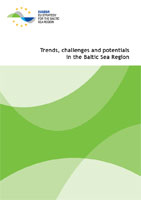Trends, challenges and potentials in the Baltic Sea Region
The report includes results from two monitoring tools, the BSR Territorial Monitoring System (BSR TeMo) and the Baltic Sea Region Regional Potential Index (BSR-RPI). The tools show the current performance of the BSR and allow for discussion on the development potential within the macro region.
The report reveals that the economic gap is closing but social and environmental challenges remain. The current update of the BSR TeMo System has demonstrated the changing nature of existing disparities. At a national level, the east-west economic divide in the BSR has been closing rapidly. At the same time, all countries are experiencing increased polarisation at sub-national level. The sharpest divide today can be found within social development. The financial crisis also appears to have hit rural areas harder than other types of regions. The result is an increasing concentration of production, jobs and people in the urban areas of the BSR. Furthermore, major environmental challenges, such as air quality in the cities and eutrophication levels of the Baltic Sea, need to be handled.
The Baltic Sea Region Regional Potential Index displays a strong performance from capital city regions and Norwegian regions Nordregio’s Baltic Sea Region Regional Potential Index covers 115 regions of the Baltic Sea Region. In the index, the region of Oslo takes the lead, followed by the by its neighbouring region of Akershus. The rest of the top 10 are the four respective capital regions of Sweden, Denmark, Germany and Finland, as well as three Norwegian regions (Rogaland, Hordaland and Sør-Trøndelag) and the region of Hamburg, Germany. The ranking is based on three categories: demographic potential, labour force potential and economic potential. Although the indicators within each theme are given different weight, depending on their importance, all the main themes are important for a region to be placed at the top of the list.
Trends, challenges and potentials in the Baltic Sea Region

- Publikationsnummer:
- Info 0658
- ISBN:
- 978-91-87903-75-5
- Årtal:
- 2016
- Länk till rapport:
- Hämta publikationen (pdf) Pdf, 54.7 MB.
